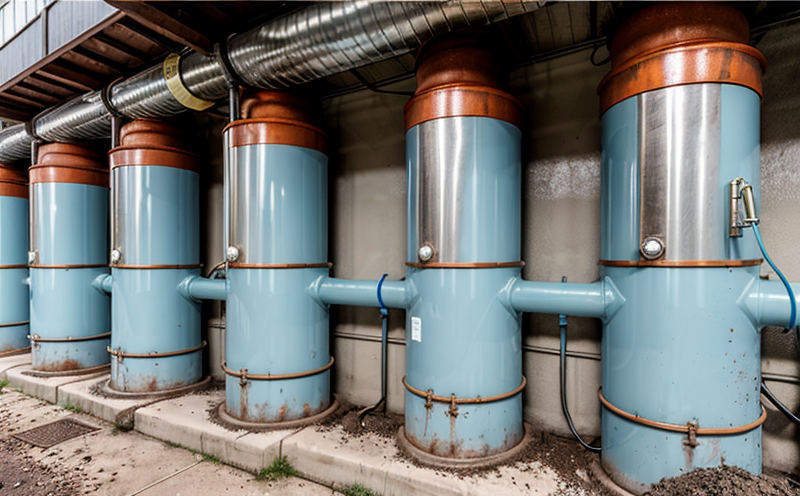ASTM D2685 Deposit Identification Test in Water Systems
The ASTM D2685 test method is a critical standard used to identify and characterize deposits found within water systems. This procedure is particularly important for those involved in the quality management, compliance, R&D engineering, and procurement of facilities that operate with large-scale water systems such as cooling towers, heat exchangers, and condensers.
This test method involves the collection of samples from various points within a water system to assess the presence of deposits. These samples are analyzed using microscopic techniques to identify the type and composition of the deposits. This information is crucial for understanding the potential impact on system performance, efficiency, and longevity. By identifying the specific types of deposits, stakeholders can implement targeted interventions to mitigate issues such as scaling, fouling, and biofilm formation.
The ASTM D2685 test follows a standardized procedure that ensures consistency across different testing facilities. The process begins with the collection of water samples from various points within the system. These samples are then analyzed using light microscopy, scanning electron microscopy (SEM), and energy-dispersive X-ray spectroscopy (EDX). This multi-faceted approach allows for comprehensive characterization of the deposits.
Once the samples have been collected and analyzed, detailed reports are generated that provide a clear picture of the deposit types present in the system. These reports typically include information on the composition, morphology, and distribution of the deposits. Such data is invaluable for quality managers and compliance officers as it provides them with actionable insights into the condition of their water systems.
The results of this test can be used to inform decisions regarding maintenance schedules, material selection, and operational procedures. For R&D engineers, this information can guide the development of new materials or processes that are more resistant to deposit formation. Procurement teams can use these findings to evaluate suppliers and ensure they meet quality standards.
By ensuring compliance with ASTM D2685, facilities can safeguard their equipment from the harmful effects of deposits. This not only extends the life of the equipment but also reduces downtime and associated costs. Additionally, this test method plays a crucial role in maintaining regulatory compliance, which is essential for any facility operating within heavily regulated industries.
The ASTM D2685 test method has been widely adopted across various sectors including power generation, pharmaceuticals, food processing, and chemical manufacturing. In the power sector, for instance, the identification of deposits can help prevent issues such as increased energy consumption due to reduced heat transfer efficiency. In the pharmaceutical industry, it ensures that water used in processes meets stringent purity standards.
The standardized nature of ASTM D2685 ensures consistent results across different facilities. This is particularly important given the variability inherent in large-scale water systems. By adhering to this standard, stakeholders can be confident that their test results are reliable and comparable with other facilities operating similar systems.
Eurolab Advantages
At Eurolab, we pride ourselves on providing expert-level services for ASTM D2685 testing. Our team of highly qualified professionals ensures that every sample is handled with the utmost care and precision. We use state-of-the-art equipment to perform these tests, ensuring accurate results every time.
Our facilities are equipped with advanced microscopy techniques that allow us to identify even the smallest deposits within water systems. This level of detail provides our clients with a comprehensive understanding of their system's condition. Additionally, we offer rapid turnaround times for test results, allowing our clients to make timely decisions based on accurate data.
We also provide detailed reports that are easy to understand and actionable. These reports include all relevant information needed for quality management, compliance, R&D engineering, and procurement teams to take the necessary steps towards maintaining optimal system performance.
Our commitment to excellence is reflected in our ISO 17025 accreditation. This ensures that we meet the highest standards of proficiency and reliability in our testing services. Our clients can rest assured knowing they are receiving the best possible service from Eurolab.
Customer Impact and Satisfaction
The ASTM D2685 test method is widely recognized for its ability to provide detailed insights into the condition of water systems. By using this test method, facilities can ensure that their equipment remains in optimal condition, thereby extending its lifespan and reducing maintenance costs.
Our clients have reported significant improvements in system performance following the implementation of recommendations based on ASTM D2685 results. This has led to reduced downtime, lower energy consumption, and improved overall efficiency. In addition, compliance with regulatory requirements has been enhanced, ensuring that facilities operate within legal frameworks.
We are committed to exceeding our clients' expectations by providing accurate, reliable, and timely test results. Our team of experts works closely with each client to understand their specific needs and challenges, tailoring our services accordingly. This personalized approach ensures that we deliver solutions that meet the unique requirements of every facility.
Customer satisfaction is paramount to us, which is why we continually seek feedback from our clients. We use this input to refine our processes and improve our services further. Our goal is to build long-term partnerships with our customers based on trust and reliability.
Environmental and Sustainability Contributions
The ASTM D2685 test method plays a crucial role in promoting environmental sustainability by helping facilities identify potential sources of contamination within water systems. By understanding the types and extent of deposits present, stakeholders can take proactive measures to minimize their impact on the environment.
This knowledge enables facilities to implement more sustainable practices such as selecting environmentally friendly materials for system components or optimizing operational procedures to reduce waste generation. The insights gained from ASTM D2685 testing also contribute to the design of more efficient systems that require less water and energy, thereby reducing their carbon footprint.
Furthermore, by maintaining optimal conditions within water systems, facilities can avoid costly repairs and replacements due to failures caused by deposits. This not only reduces operational costs but also contributes to a cleaner environment as it minimizes the need for frequent maintenance activities that could result in waste.





